Despite being just 21 years old, Amine Gouiri is already being heralded as one of the superstars of the future. Considering the quality coming from French football and the incredibly talented 2000-born Olympique Lyon academy generation that’s already marking modern football, it’s easy to believe the hype. Following the success of the French school of football that’s seen the likes of Real Madrid’s Ferland Mendy, Nabil Fekir, Eduardo Camavinga or Bayern Munich’s Dayot Upamecano rise to stardom, OGC Nice are looking to replicate their success with Gouiri.
But what do we know about the 21-year-old prospect and what does the future hold in store for him? This tactical analysis will give you a full scout report of his player profile and use further analysis to dissect his role in Nice’s tactics.
Player overview
Amine Gouiri is a 21-year-old player currently playing as a left-winger or a centre-forward for Nice in Ligue 1. Standing at 180 cm (5’11) and weighing 72 kg, the young attacker is not a massive physical presence on the pitch but can boast great agility, decent pace and good technical control of the ball. Looking at his player profile through data in the graph below, we can see some of his main strengths and most important traits.
Quite clearly, Gouiri excels in both the attacking and creative aspects of the game and is the main piece of Nice’s jigsaw in possession. The most impressive statistical outputs we can see below concern expected goals (xG) per 90 minutes (0.58), the percentage of shots on target (58.33%), assists per 90 (0.20) and dribbles per 90 (5.07), all of which put him among the best performers in Ligue 1. This, considering both his age and the overall quality of the team, is very impressive.
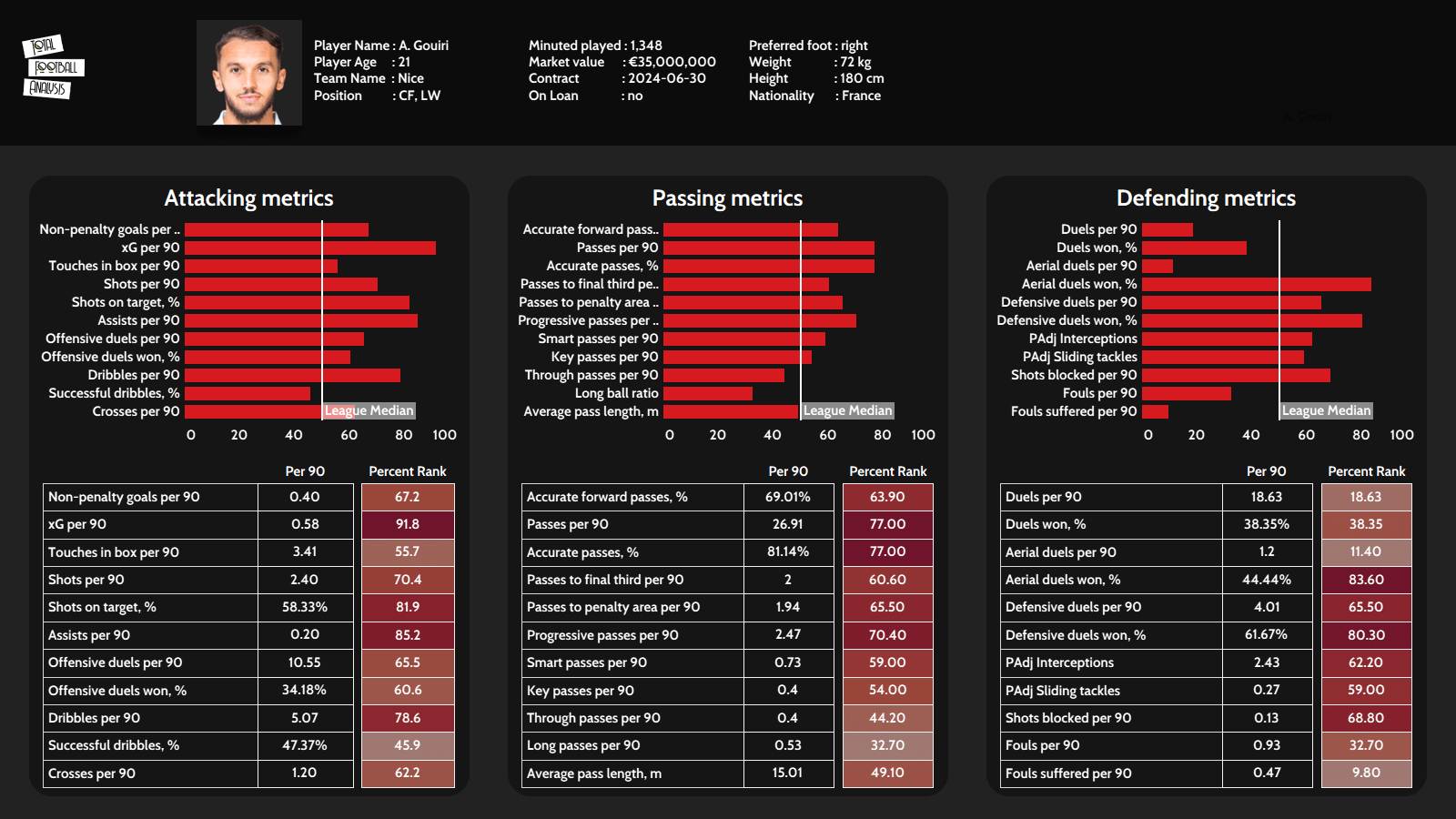
Apart from being highly important in scoring goals, Gouiri is a great creator for the French outfit. Being a forward with more freedom to drop deeper and orchestrate play beyond the final third, the 21-year-old is very involved in the build-up and progression of the ball. We can see as much in the data above as well, as his ball retention, progression and even access to the danger area are all above the league average. This suggests a very complete attacking profile but, as we’ll see later on in the analysis, he isn’t flawless in these aspects just yet.
Defensively, even though the stats would suggest a decent output, Gouiri still has a lot to improve off the ball. But that much is expected from a player of such tender age who’s very much in development. Still, despite a very low volume across the board, the youngster can be effective when he does engage in duels.
This tactical analysis will now turn to some of his most prominent traits while also dissecting some of Gouiri’s main weaknesses, both on and off the ball. Considering we’re talking about a very young player, it should come as no surprise that there are still areas he needs to improve going into 2022 and beyond.
Carries, dribbles & creation
Without too much doubt, the strongest weapons in Gouiri’s arsenal come from the technical side of the game. His progressive carries, dribbles and involvement in shooting and goal-scoring opportunities are all on a very high level and clearly stand out from the rest. While the 21-year-old is a forward by nature, he tends to be very involved in the play in deeper areas of the pitch. In this section of our scout report, we’ll address some of those aspects and see how they transfer onto the pitch and affect Nice’s tactics.
Dribbling, in particular, is something that immediately stands out. With 5.07 dribbles per 90 (47.37% success rate) and 2.94 progressive runs per 90, Gouiri is very good at running at the opposition and leading the transition with the ball at his feet. Before we analyse his technique and tendencies in possession, let’s first consult the graph below which will show us the locations of his dribbles.
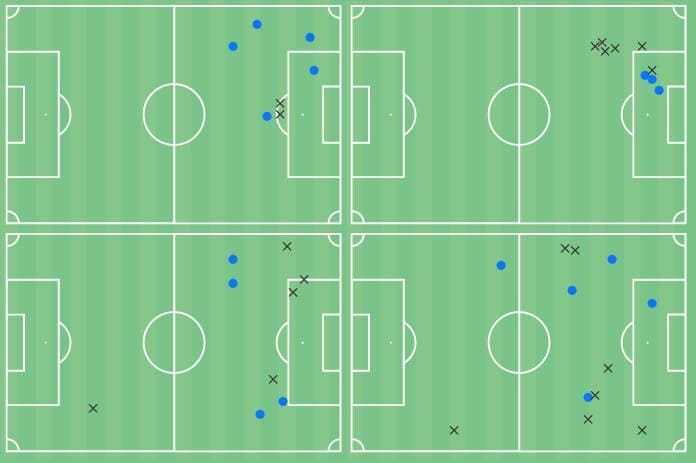
We can see that most of his dribbles are attempted in the left half-space and around the edge of the opposition’s penalty area, either just inside or just outside of it. Of course, since he is often afforded a lot of freedom in movement and is versatile enough to be deployed practically across the forward line, it’s not uncommon to see him on the right. There, too, his dribbling tendencies are very similar. Even though he’s right-footed, and heavily so, he will prefer to dribble towards the inside of the pitch, cutting in and approaching the box at an angle via the half-space.
As far as his technique is concerned, Gouiri is at his best when running at the opponent as his good close control at high speeds allows him to glide past markers with relative ease. Generally, the 21-year-old is good in tight spaces too but his heavy right-footedness can work against him in 1v1 duels when he’s not afforded enough space to run into. His turn of pace is good and he is agile enough to beat defenders but can become predictable, almost always preferring to dribble towards his dominant foot.
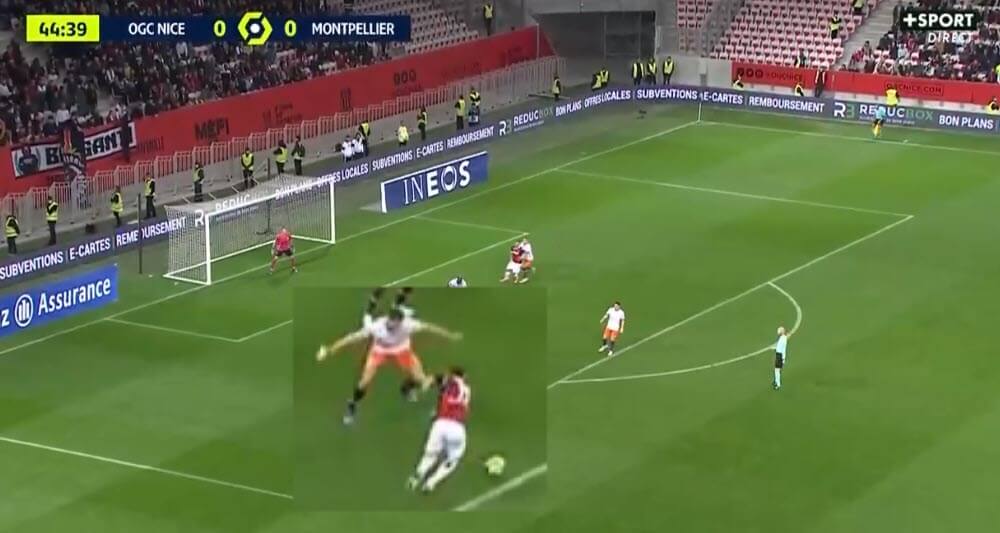
Above we see a very good example of this. Gouiri is positioned in his preferred area for both shooting and dribbling and we also see this tendency to cut towards his right foot. The defender, however, is ready for the move and can successfully stop the young talent even when he tries to change direction towards the left. This is not to say that his dribbling is bad — it’s definitely not — but he can be a bit too predictable and somewhat static, lacking that electric change of pace akin to some of the best dribblers like Lionel Messi or Neymar. Of course, he is very young so there is a lot of room for improvement left.
Staying on the topic of control, Gouiri’s first touch is good, albeit can do with some improvement, especially when controlling more difficult passes that either have more height or power to them. A very important aspect we have to mention here is scanning as that gives him enough information to decide how to control the ball. This is crucial and allows the youngster to swap between a heavier touch with the inside of his foot and immediate stepovers towards either side or immediate turns with the outside of the boot. Because of that, I believe he is fairly press-resistant and can be used well in lay-offs and link-ups. However, despite being fairly tall, Gouiri lacks pure brute strength and can be muscled off the ball and forced backwards.
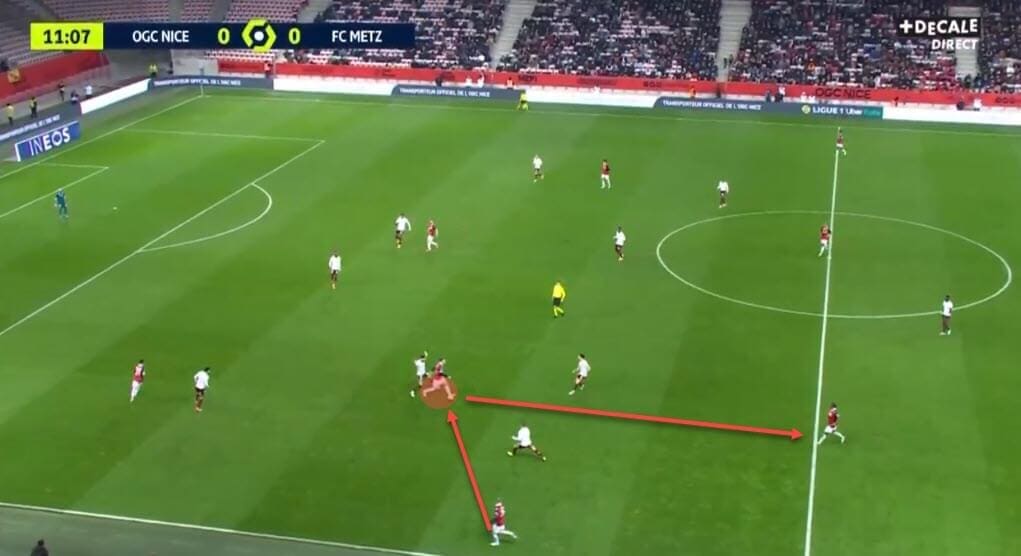
In the example above, we can see him under pressure immediately after receiving the ball from his teammate. With the marker harassing him and Gouiri lacking the strength to fend him off, he is easily forced to pass backwards. Of course, this isn’t always the case. We already established him to be fairly press-resistant so often, having previously scanned his surroundings efficiently, he can turn with the ball and avoid the direct physical duel with his marker. But when he can’t avoid those challenges, he’ll likely be stopped or forced backwards. The positive Nice — or any other future team — can get from that is that Gouiri is good at drawing fouls through his dribbles. This is especially effective in the final third of the pitch, of course.
But speaking of passing, next we’ll analyse that aspect of his profile. Below you can see graphs of some of his most recent passmaps from games that gave us a big enough sample to dissect. Immediately, we can notice some interesting tendencies across all four clusters.
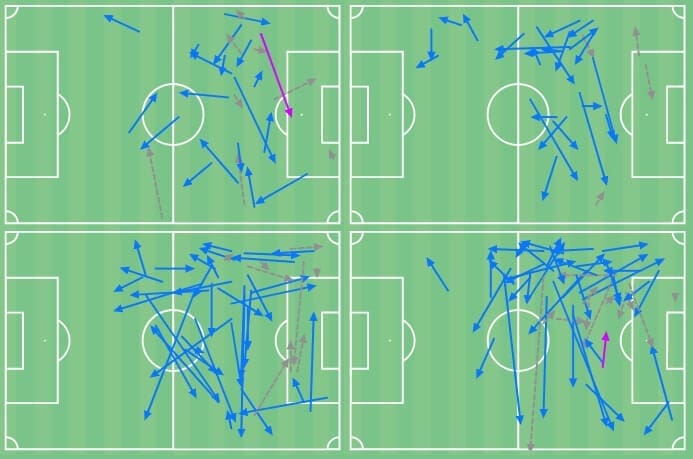
Generally speaking, with an average of 26.91 passes per 90 minutes, Gouiri is heavily involved in his team’s ball retention and the build-up phase of their attack. This is important as it tells us a lot about his profile, which is not exclusively geared towards goal-scoring output but is far broader than that. Next, we can recognise some specific types of passes within the clusters, starting with the backwards-pointing one we discussed earlier in the analysis. These are mostly the result of Gouiri being forced back with a marker on his back or when he’s simply used in ball retention sequences when he drops deeper.
With 81.14% accuracy, it’s fair to say he’s generally secure on the ball but can occasionally mishit simple passes that shouldn’t be misplaced. Considering he has the technical quality and the vision good enough for much more, this is a flaw that should be completely ironed out with time. It also remains to be seen whether it’s an issue on a technical level or just a result of lapses of concentration. Another cluster of passes we have to notice here are the vertical and diagonal balls. This is where his creative profile shines the most. Gouiri is capable of threading passes between the lines and finding teammates in difficult positions.
We can see a good example down below. Here, he combines with another player in a quick one-two, bypassing two markers and then also exploiting space beyond them too. This is a good sequence showing smart passing he has in his arsenal and it’s certainly something that has contributed to his good statistical output too, as can be seen from the initial player profile graph at the very beginning of our tactical analysis.
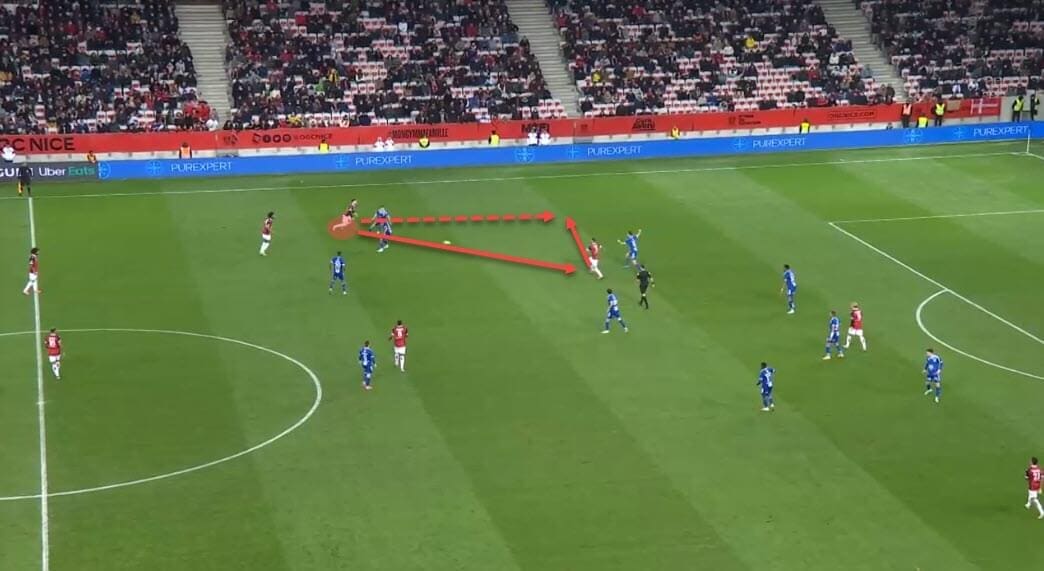
The key in this sequence is also the movement that quickly follows the pass. It’s something that won’t show in the numbers but can be easily noticed in the eye test. And while I’d say he does this fairly often, off the ball movement is certainly an area Gouiri can and should still improve over the years. But we’ll touch upon that aspect in the next section of our scout report. Staying with passing, however, there’s still one cluster of pass types we have to address — long passes.
In Gouiri’s instance, long passes include switches and crosses, both of which are a relevant part of his arsenal. We can see from the cluster the 21-year-old will often switch play and do so successfully from left to right. One such example is below as Gouiri tries to exploit the space Nice have managed to secure on the opposite side of the pitch. It’s very encouraging to see him successfully switch play and find his teammates with accuracy and speed.
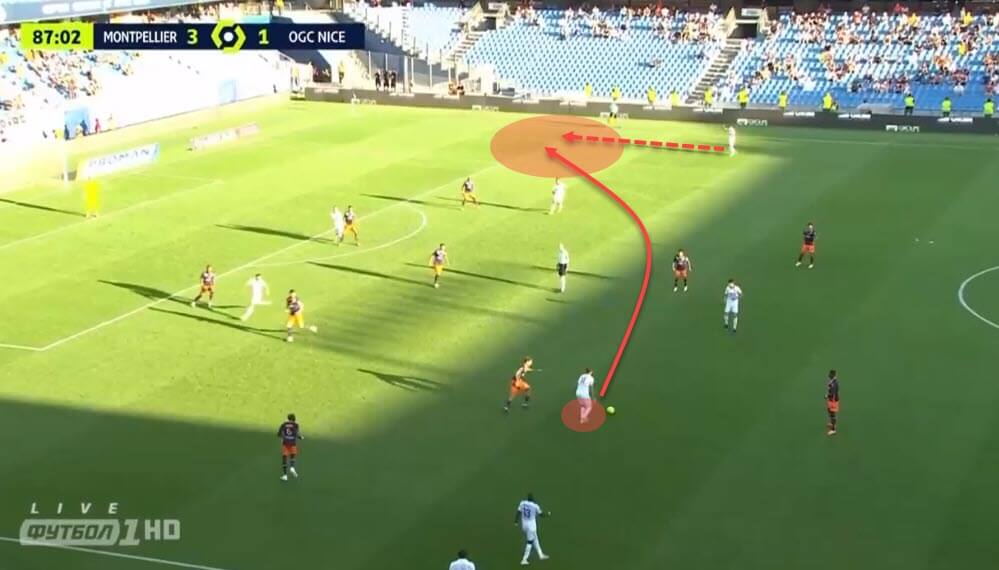
This kind of passing and movement suits him perfectly because when he cuts in from the left side, it positions him naturally to deploy passes with his right foot. The same thing happens with situations in which Gouiri is tasked with crossing into the box. Considering he’s a left-winger, at least on paper, his technique when crossing the ball is different from the more traditional wide players on that side of the pitch.
Since he is very right-footed, Gouiri will aim to position himself around the corner of the opposition’s penalty area, cutting back towards the outside so he can deploy crosses with his stronger and dominant foot. You can see that area highlighted in the example below that ultimately turns into an assist for Nice.
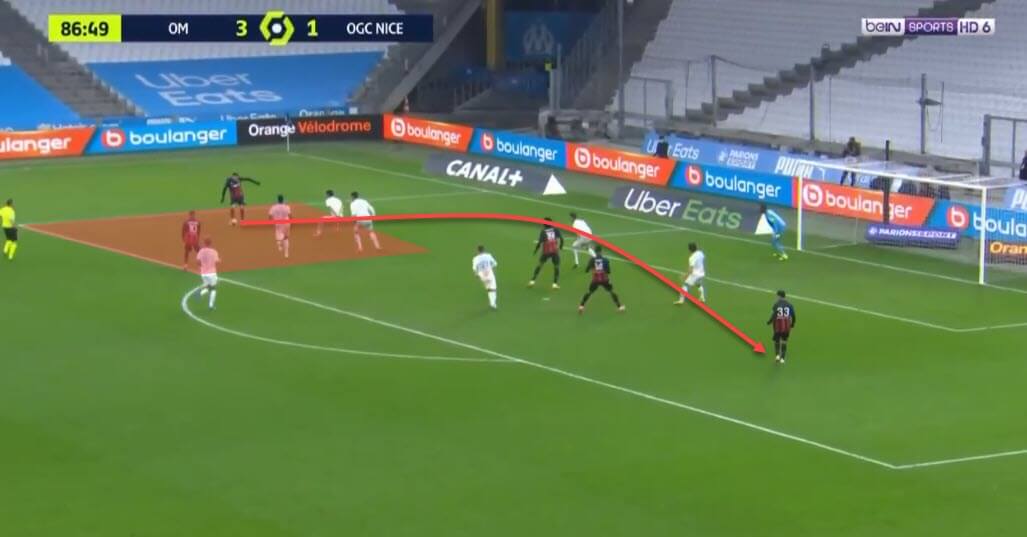
This, of course, can also be predictable and easier to stop. Potentially working on being able to use his left in such instances, and especially when shooting and dribbling, would make him much more effective and lethal.
But speaking of lethality, we’ll now turn to his movement and performance in front of goal in the next section of this tactical analysis.
Finishing & movement
Even though I labelled Gouiri’s progressive carries as probably his best trait, every forward, no matter how versatile in his approach and deployment, is also judged on the offensive output. And offensive output largely comes down to performance in front of goal. Of course, being a big part of Nice’s creation as well, the youngster contributes to that phase of play in more ways than one. However, he is also a good finisher too.
But we’ll come to that part a bit later. First, let’s discuss his role and movement. Below, you can see Gouiri’s heat and action map for the ongoing 2021/22 season in Ligue 1. His profile is versatile enough for the youngster to be deployed across the forward line but he does prefer the role of an inverted winger from the left side of the pitch. Usually, that will be within Nice’s 4-3-3 system – more used last season – which allows him the freedom to both cut inside and drop deep when necessary. This season, we’ve seen the French outfit utilise the 4-4-2 and Gouiri often as part of the forward duo to a similar effect.
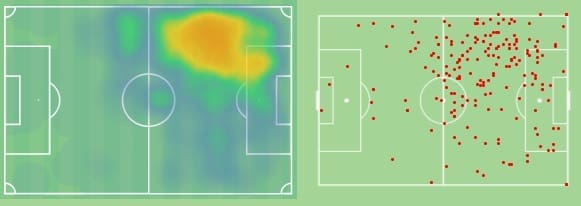
And despite him having the ability to play as a centre-forward, it feels he performs better as the false nine, playing off of a true nine. That’s because he prefers to link up with the midfield and assist the build-up in deeper areas. Similarly, by allowing him to drop deeper, Nice can utilise his good passing range for both creation and retention purposes. Gouiri will, however, often start wide and higher up the pitch but will eventually cut inside to allow for the overlap. This suits him even better because it positions him onto his stronger foot while also allowing him to stay between the lines where he’s very dangerous.
A fairly standard sequence in attack would then include him receiving out wide and then cutting inside to face the defenders while on the run. We’ve already discussed how his dribbling technique from a standing still position is not as effective as he can feel a bit too static but when he’s running at the marker(s), it’s much more lethal and successful. You can see a very similar instance in the example down below.
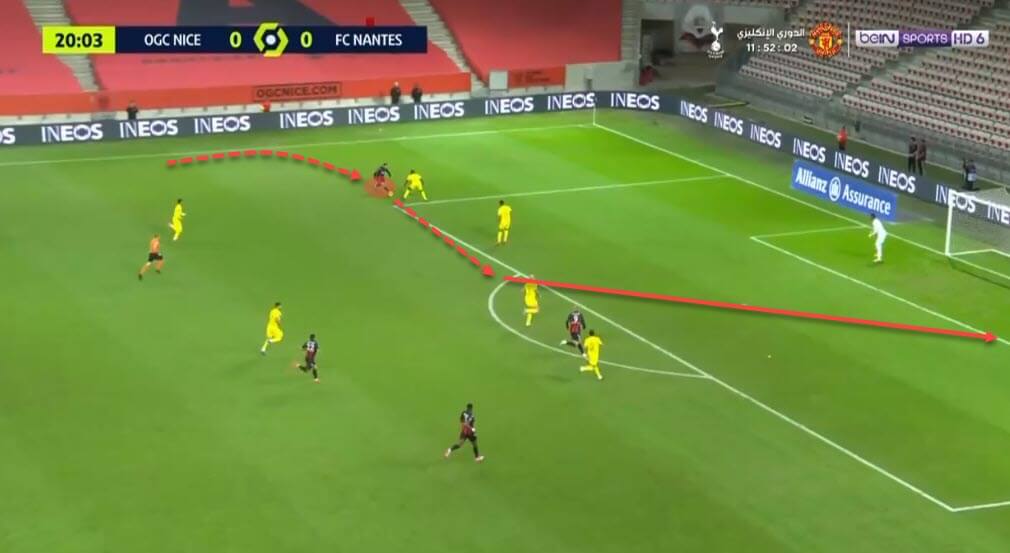
In this sequence, you can see him glide past the defender almost effortlessly following a cut-in from the left flank. Gouiri has excellent close control at speed, which, intriguingly, isn’t fully replicated when standing still. We’ve already discussed in this scout report how he can sometimes suffer from lapses of concentration and miscontrol or misplace simple passes. Generally, however, his technical quality is still at a high level overall.
But another big aspect we have to discuss here is the shooting. Firstly, the location from which he attempts the shot is important as this is generally where we’ll see him arrive when he’s progressing into the box. This area in and around zone 14 or just inside the box entering from the left is the one he’ll often aim for. And once he reaches it, he’ll have a direct go at the opposition’s goal.
We can see this from the following shot map.
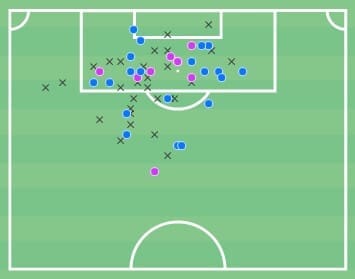
The shot map contains his last 75 efforts, excluding any potential penalty kicks too, and shows us goals, shots on target and the ones that have missed the target. Overall, we can say that Gouiri seems to be a volume shooter with 2.40 per 90 minutes, enough to position him in the top 30% in the league in sheer output. Concerning his shooting technique, it’s good but not exactly refined as of yet. 35 of the last 63 shots have been attempted with the top of the foot, scoring five goals, while 23 have come from the inside of the foot, amounting to four goals. Despite that, Gouiri rarely shoots with a lot of power, preferring placement and smart finishing over rattling the inside of the net with a rocket.
But it has to be said that with 0.40 non-penalty goals per 90 and 0.58 expected goals per 90, he is underperforming the xG values. This could be closely related to the number of touches he takes in the box before attempting a shot. His touches inside the box per 90 are just above the league average (3.41) but considering only 19 out of the last 50 shots from inside the penalty area have been after a single touch with the rest (31) coming after two or more, we can say he needs more time to adjust. Similarly, only three out of the seven goals scored inside the box were one-touch finishes. So when he’s awarded more space and time to take additional touches to reposition, he’ll likely do the job well but if not, he might struggle.
And repositioning is quite important. We’ve already mentioned how Gouiri is heavily right-footed and this inevitably accounts for the extra touches as well. After all, 58 out of the last 63 shots were taken with his right, which can make him quite predictable at times. Below, you can see an example of a very well placed finish.
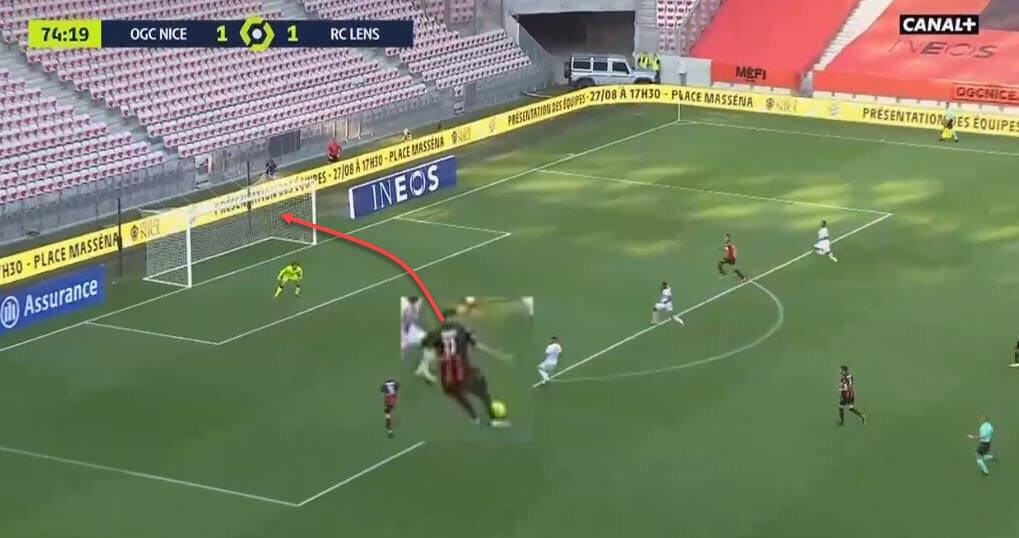
Notice how it’s not an extremely powerful shot but rather a smart one, taken with the inside of his foot. This will often be the case too. But there’s one final thing we have to discuss regarding Gouiri’s offensive movement. The youngster is fairly disciplined tactically, knowing where to move but there is still room for improvement.
For instance, he can be very static at times, not opening himself to reception enough nor exploiting the space either vacated or created by his teammates. He will also almost always prefer to come short to collect the ball to his feet in deeper areas. Sometimes, that can affect the momentum of the play. Of course, such things will come with maturity and more tactical understanding but so far, it’s not at the highest of levels just yet. He needs to be more creative in his movement, adjusting according to his teammate’s tendencies. If the centre-forward drifts away from the central position, Gouiri has to recognise where he should be positioned so Nice can exploit it.
Similarly, if he’s the centre-forward, he has to think about what areas to occupy. We know he loves to have freedom of movement but sometimes, the team will need him to pin the backline in the central channels instead of drifting wide or dropping deep at will. In the example below, you can see him strolling without even trying to exploit the space his teammates are creating through their adjustments.
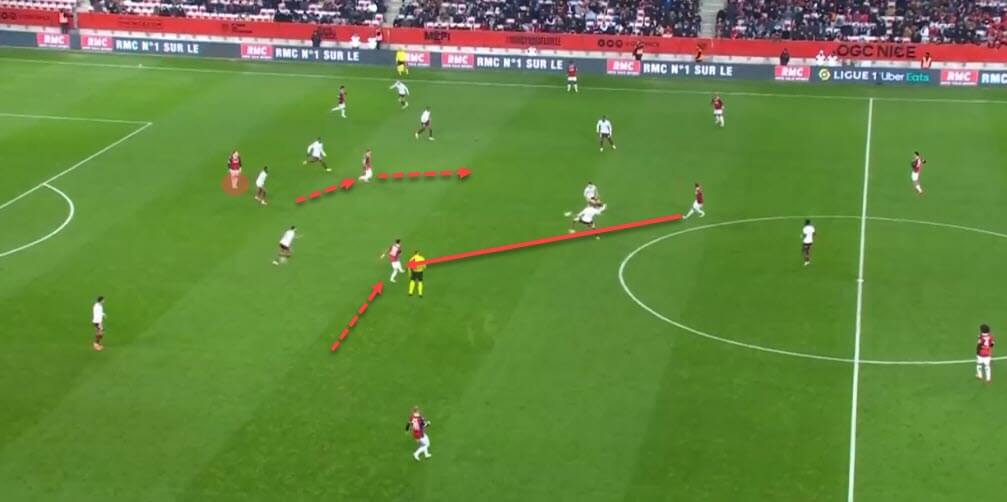
This can come off as lazy and it does seem like he needs to work on his off-ball movement. The same can be said for defensive output too. Even though the data suggest an above-average success rate, he’s not engaging in pressing or duels nearly often enough. If he’s planning to get a big transfer soon, these aspects will have to be improved upon.
Conclusion
Amine Gouiri is a massive talent and definitely a player that can not only mark 2022 but also the future of modern football. The foundations are all there but despite his technical quality, pace and smart finishing, there are still very important aspects he needs to work on. First and foremost, the work he does off the ball lacks clear understanding and intensity. Adjusting to his teammates’ needs and positioning is key as the team will otherwise suffer for it.
Overall, however, there are a lot of things to like in his profile, as this tactical analysis has shown. If he works on the aspects we’ve highlighted as somewhat lacking, I’m sure he can have a great future.

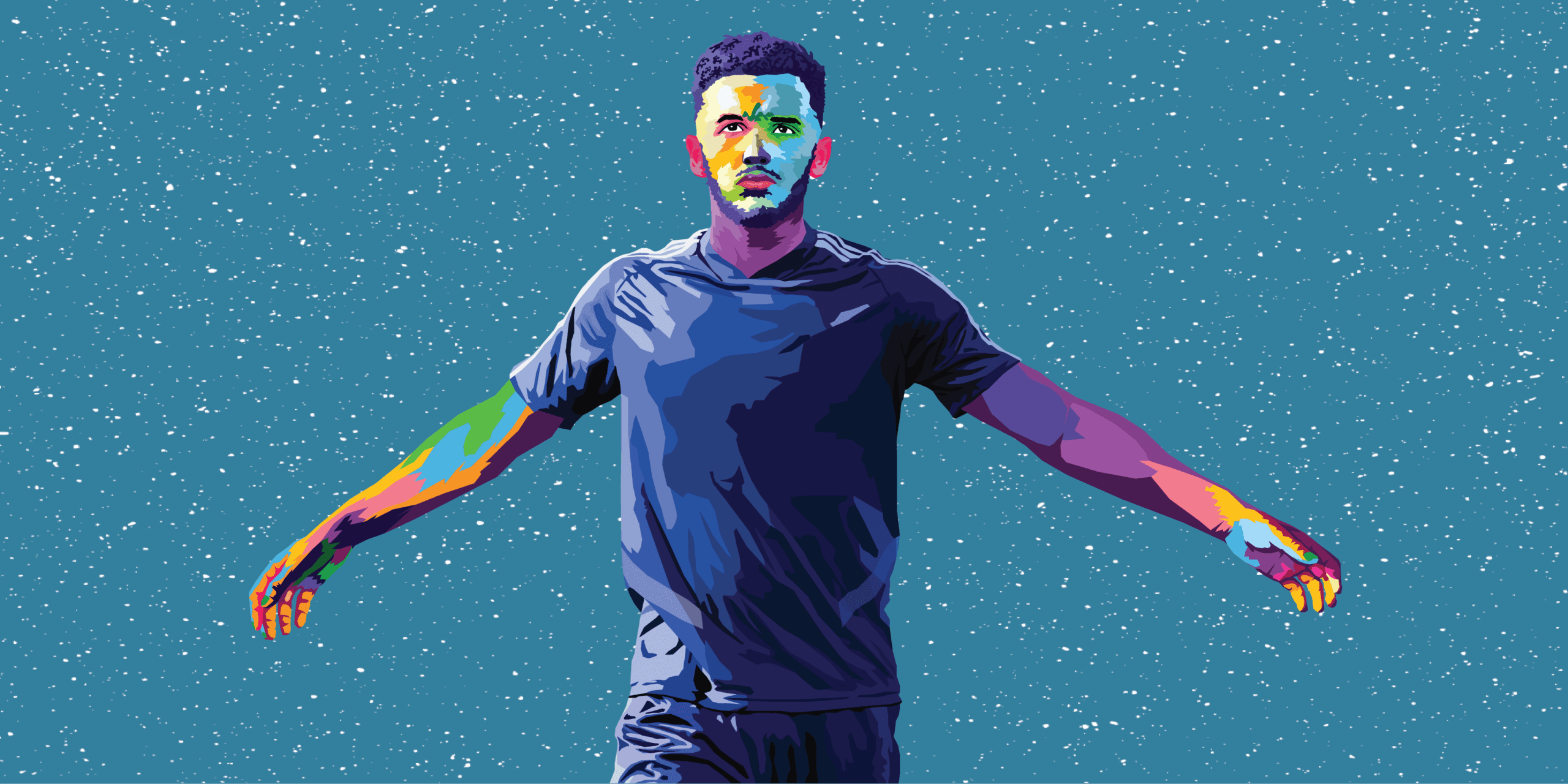



Comments